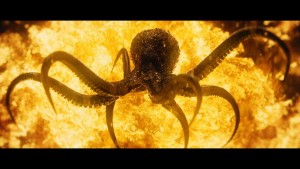 Director Sam Mendes recently tapped London-based Framestore and sequence director Daniel Kleinman to create the open titles sequence for Spectre the latest installment in the James Bond franchise.
Director Sam Mendes recently tapped London-based Framestore and sequence director Daniel Kleinman to create the open titles sequence for Spectre the latest installment in the James Bond franchise.
The creative process spanned almost four months, involving more than 30 artists and producers, who worked closely with Kleinman to define the images, style and tone of the sequence. For teams accustomed to creating shorter, snappier commercial spots, the Bond titles are a chance to approach the work in a different way. “There’s more scope, for sure,” said Framestore executive creative director William Bartlett. “On a commercial the work tends to be more buttoned-down, with a greater focus on the technical rather than the creative. There are technical challenges here too, of course, but the emphasis is on the creative exploration.”
The work kicked off in May, after the sequence director Kleinman received the call-up from Bond producers Michael Wilson and Barbara Broccoli.
After reading the script, Kleinman met with Framestore to start concepting visual idea. With six Bond sequences already under his belt, Kleinman knew exactly how to approach the work. “I don’t have any preconceived ideas, anything stored up or saved up from other things when I come to the job. It’s important that the ideas and visuals are narratively driven. In most Bond films there’s a theme that runs throughout. That will be the thing that I take and run with, try to find the visual metaphors, and have some fun with the idea of it.”
Framestore’s artists received word of key elements, and started to block out the initial storyboard, with some pre-visualization work. “Generally with Bond titles, the motion and flow of things is key,” said Bartlett. “Plotting the sequence out with camera moves and segues really helps, even if only with the use of placeholder images. We start to see it, and get a feel for the piece. You reveal some of the themes you’ll see later on, present some in an abstract way, but at the time it’s just an image, something to come back to later. It’s something we think about quite carefully when we’re working.”
Primary elements included the octopus, and a focus on love and relationships, not typical of recent Bonds. Of course, there are the staples like girls, guns and the occasional skull to remind us of the heritage surrounding the film. Bartlett explained, “People really want to see the familiar things, but feel they’re seeing them in a new way. It’s a challenge, but it’s fun, and those basic elements are really good elements.”
Artists from Framestore attended the three day titles shoot to collect the many stylistic elements and special effects to be used throughout the sequence. Fiery elements were supplemented with macro work in a tank, capturing high-speed droplets of ink in water, which would be used extensively, particularly around the dancing female figures and in the memory sequence. The CG simulations were technically intricate, especially when paired with the challenge of using archived footage from past Bond films.
“It’s quite easy for it to look a bit stuck-on,” said Bartlett. “The pieces come from different environments, were shot on different cameras. One of them is underwater, yet we needed to make them look like they were all shot for this sequence. We were able to use the song lyric, about shattering glass, to our advantage, stylizing the sequence in a way that brings all of the past elements together.”
The glassy reflections and refractions also gave the artists an opportunity to use V-Ray in Nuke, a tool that allowed improved 3D-style rendering. Otherwise it was “the usual suspects” in terms of software, said CG supervisor Simon French: “Maya for animation, Houdini for a lot of effects, and Nuke of course for Compositing. We intended to render through Maya and Arnold, but due to technical reasons moved to render in Houdini, the first time we’ve done so on a big project in Integrated Advertising.”
Kleinman noted that the tune and titles rarely come about in a single process. “I often start creating the title sequence before I’ve heard the song. For Spectre I heard the track reasonably early, not a finished edit, but it was helpful. I tried to link the images to the lyrics occasionally, not so it’s pedantically illustrative, but with a lightness of touch.”
“‘Writing’s on the Wall’ is, in essence, a love song, which is strange because Spectre is such a sinister word,” he added. “It’s actually one of few instances that the title doesn’t appear in the lyrics at all. It’s an interesting dichotomy, trying to make a long song at once ominous and sexy, reminding us of the love story behind all of this Bond action.”
Bartlett noted that the pace of the song certainly impacted the work. “It’s very important that the audio and visuals work well together. It is tempting to put every single thing on a clear beat, but it would feel a bit obvious. We actually refrained from trying to cram things in, slowed it down and took out some scenes to allow the piece to breathe. It’s more interesting to look at fewer scenes, and work on blending them together well.”
“Skyfall was quite a hard act to follow, but I really feel with this one that we have pushed the boundaries of what we can produce,” said head of production Helen Hughes. “In terms of standard and creativity of work it is up there with the best Bond title sequences.”





